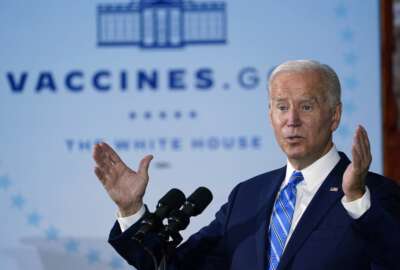

Biden administration officials point to “great strides” in agencies progress under the President’s Management Agenda, just after it hit its one-year anniv...
Best listening experience is on Chrome, Firefox or Safari. Subscribe to Federal Drive’s daily audio interviews on Apple Podcasts or PodcastOne.
Just over a year in the making, the President’s Management Agenda has reached some significant milestones, according to Biden administration officials.
But the work is far from over — agencies have a lot to do ahead to make the long-term management changes included in the PMA, said Jason Miller, deputy director of management at the Office of Management and Budget.
“Transformational change, which is our objective, takes time. But to get there, you need to put some points on the board early and drive momentum and be clear about ultimately what success looks like. And that has been a big part of the work. A year in, we’ve made some great strides,” Miller said at a Dec. 13 event marking the one-year anniversary of the PMA.
Some of those recent strides, particularly for the first priority of the PMA — strengthening and empowering the federal workforce — included holding the first-ever meeting of the chief diversity officers council. OMB further pointed to the creation of an employee engagement working group and recent guidance around future office workspace plans as other key milestones.
Beyond this progress for the PMA, though, agencies should be continuously collecting data in four different areas, to measure how they’re approaching PMA goals. Leaders from the Office of Personnel Management, along with the Department of Defense and the Labor Department, called on all agencies to look at metrics outlined in the PMA’s first priority and track their progress toward the objectives.
“[Those are] focused on employee engagement, mission-critical hiring and staffing targets, hiring manager satisfaction with the hiring process … as well as our new [index in] OPM’s Federal Employee Viewpoint Survey focused on diversity, equity, inclusion and accessibility,” Ahuja said at the PMA event.
First, agencies should look at and measure progress on how engaged their employees feel. Using the employee engagement index in FEVS, agencies should either pick a focus area — among supervisors, leaders lead or intrinsic work experience — or otherwise look at a handful of questions from the index. They can then identify gaps in responses among different offices within the agency, and take actions to start improving some of the poorer scores. They’ll have to pick their focus area by the end of January and provide OPM with an update by the end of 2023. Ultimately, agencies should aim to narrow the identified gaps by 20% by the end of 2024.
Additionally, agencies should measure hiring managers’ satisfaction with the internal hiring process. They can collect and analyze data from the results of the existing Chief Human Capital Officers hiring manager satisfaction survey. With that information in hand, agencies should then identify challenges and implement strategies to improve satisfaction among hiring managers.
“[We’re] ensuring that there’s a lot more human capital data out there that we’re providing to agencies, to really have a lot of this [PMA progress] be driven by innovative, data-driven solutions. The work that we’re undertaking at OPM is a big part of the PMA — it’s intentional and it’s focused. We’re taking a really collaborative approach in working with agencies across government,” Ahuja said.
Attracting the right talent to the right roles is another area where agencies can measure progress under the PMA, according OPM, DoD and Labor officials. Agencies should set internal targets for both agency-specific and governmentwide mission-critical occupations, as well as for cybersecurity positions. Hiring projections for those positions are due by Jan. 30 for agencies. They’ll also have to report to OPM on their annual progress toward reaching hiring and staffing targets that they’ve set.
Finally, agencies should be collecting data on progress around DEIA strategies. That’s a new index this year in FEVS, which agencies can use as a benchmark to measure changes in years to come. The survey results can show areas of particular strength and weakness in DEIA initiatives, as well as any significant gaps in employees’ responses. Agencies should also work with their internal chief diversity officers to identify and mitigate any barriers to improvements.
“We have close to 20 agencies, including our strategy leads, who are developing goals, metrics, milestones and activities under the PMA,” Ahuja said. “There’s just a lot of really good data for us to pull. We want to set these metrics that we’re going to work on across the federal government.”
Part of these efforts to improve federal recruitment means placing greater emphasis on early-career hiring. Colleen Heller-Stein, the Treasury Department’s deputy CHCO and director of the office of human resources, said her office is taking steps to boost early-career hiring efforts. For instance, a new tool on USAJobs.gov can help highlight federal internship opportunities.
“We think that this will make it easy for candidates to find our opportunities,” said Heller-Stein, who’s a strategy lead for the first PMA priority. “And we’ll highlight things like that, along with other paid internships for students.”
Additionally, the Treasury Scholars Program, focused on recruiting students for paid internships, partners with minority-serving institutions to try to use DEIA in hiring. So far, as a result, around 60% of Treasury interns who were people of color came through that particular program, Heller-Stein said.
Beyond the first PMA priority of strengthening and empowering the federal workforce, improving federal services and customer experience, the second major component of the PMA, has also seen some progress over the last year.
For instance, the General Services Administration has plans to redesign the USA.gov website to streamline and make more accessible a lot of the information that’s available. In another example, OMB said a recent redesign of Medicare.gov will make it easier for users to navigate.
The Department of Veterans Affairs is also heavily involved in many of the customer experience changes that the PMA highlights.
“The PMA has allowed us to establish a quarterly cadence of connecting the dots between customer experience and critical enablers, like workforce and how acquisitions and grants are managed,” VA Deputy Secretary Donald Remy said at the PMA meeting.
It’s also been just over a year since President Joe Biden issued an executive order on transforming federal customer experience and service delivery to rebuild trust in government.
“That EO, coupled with the work of the PMA, has given us the organizational momentum to actually focus in a way, that I don’t think we were focused before, on these crucial services. [We can] identify, as well as remove, friction that previously might have existed [and] that our veterans may have experienced,” Remy said.
The third and final PMA priority, managing the business of government, focuses on improving federal acquisition and financial assistance systems. Agencies have made progress in this priority area as well, OMB officials said.
“Strategy teams have already identified a number of milestones and metrics they will use to drive and measure progress,” OMB said in a Nov. 30 blog post.
Some of those measurements include looking at how much opportunities for small business federal contracting have improved, as well as working to reduce barriers to entry for federal acquisition. Improving the federal acquisition workforce itself is another focus area to accomplish those goals — and some agencies have already made progress on that.
“For instance, OPM has streamlined the hiring of grants management specialists,” OMB said.
Notably, the Biden administration’s PMA overall was the first to issue a learning agenda, centered on building evidence and data for agencies to make decisions and evaluate progress toward the agenda’s goals. It’s also the first PMA to explicitly name core values — equity, dignity, accountability and results — to help define progress in the three priority areas.
“We are committed to making sure that it is all data-driven in both the targets that we’re setting and the measurement on an ongoing basis,” Miller said. “We now have over 30 success metrics that we’re going to be using to track and demonstrate our progress. There are going to be places that we fall short, and that is OK. We want to be transparent about that and hold ourselves accountable.”
Copyright © 2024 Federal News Network. All rights reserved. This website is not intended for users located within the European Economic Area.
Drew Friedman is a workforce, pay and benefits reporter for Federal News Network.
Follow @dfriedmanWFED


